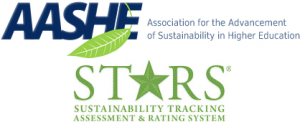September 2013 – Volume 16, Issue 1: The Corporate Green Special
IN THIS ISSUE
Flanigan’s Eco-Logic
Newsweek’s Green Rankings
Carbon Disclosure Project
Small Businesses
Starbucks
JP Morgan Chase
Travelogue: CO and NM
26th E Source Forum
Stars at Central New Mexico CC

Flanigan’s Eco-Logic: Big and Smart Business
The greening of corporate America is big business. For corporations, green is all about the bottom line… and finding new opportunities. Even oil men like T. Boon Pickens consider this a vast land of opportunity, perhaps the greatest since the Louisiana Purchase.
Stephen Ambrose’s account of the building of the transcontinental railroad is riveting; there was “nothing like it in the world.” Clean tech opens vast new frontiers. It’s a bonanza. The greening of America’s energy infrastructure may be as big an economic boon as linking the East and West coasts in 1869.
So what is a “green business?” EarthShare suggests that “a green business strives to have a positive impact on the environment and community. It develops and practices business strategies that go beyond regulation and demonstrate commitment to a healthy and sustainable future.” Another take: “A green company acts, or claims to act, in a way which minimizes damage to the environment.”
There are major drivers for the steep rise of green companies. Regulation is impending, so smart companies are seeking to get ahead of the curve. There’s huge consumer green product demand. For many companies, it’s about attracting top talent. Others are attracting investors, many in growing socially responsible investment pools. Scrutiny will increase; certifications will shift from voluntary to required. B Corps provide societal benefit – claiming their verification is what Fair Trade is to coffee, or USDA organic certification is to milk. B Corps, certified by the non-profit B-Lab now number 760 in 27 countries.
Awards galore for the greenest of the green: Fortune’s “top ten green giants” includes Honda, recognized for its “green fleet,” the most efficient in the world. Goldman Sachs rewarded for investing in wind farms; Hewlett Packard for its computer recycling programs; Pacific Gas and Electric for methane generation.
There are two primary ways corporations can go green. First is to sell green products and services. There are hundreds of thousands of big and small companies innovating and changing the face of our energy infrastructure, products and services… nothing short of Amazon-style!
Bank of America has lent $20 billion in the green space, and now is onto its next $50 billion investment phase. Tesla not only produced the world’s safest car, but also the sleekest all-electric car to date. This is not just big business, but smart business. Morgan Stanley talks about opportunities: “harness the power of markets to foster sustainable growth and opportunity….” Solar Mosaic promotes solar crowd-sourcing and investments.
The second way to green a company is to green internal operations and practices. Morgan Stanley’s detailed 8-page environmental policy statement states that climate is changing, citing specific environmental threats such as biodiversity loss, justifying strict buying guidelines for green services. Google, with its massive data centers, has earned notoriety for cutting energy use by 50%, and buying all the power for these centers from renewables. Facebook, in a reversal, decided to buy renewable power for its data centers.
What about your company, your means of business, your enterprises? Do you operate with a set of environmental and social principles? Does what you are making and selling have a role in the sustainable marketplace?
How might your products and services be greener? How about your operations? Food services? How can you engage deep savings most cost effectively? Have you effectively engaged employees in this effort? EcoMotion is prepared to strategize with you.
Corporate Sustainability
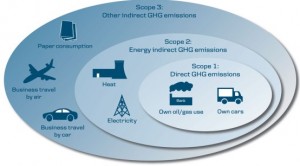 Sustainability fits into a business environment in different ways – it may be in facilities, finance, corporate responsibility, public affairs, or environmental affairs. Often a champion rises. And it has many different forms, from sweeping policies to daily operations.
Sustainability fits into a business environment in different ways – it may be in facilities, finance, corporate responsibility, public affairs, or environmental affairs. Often a champion rises. And it has many different forms, from sweeping policies to daily operations.
The other day I had lunch in an Orange County corporate cafeteria. Just outside was the new vegetable garden maintained per contract with the food service provider, its bounty used by cafeteria chefs.
The year 2012 was “a breakthrough year for Scope 3 emissions,” from supply-chain management, to business travel, waste, and procurement. The World Resources Institute – one of the leading organizations standardizing emissions reporting protocols — released its Corporate Standard. It includes Scope 3 supply-chain management reporting. The Carbon Disclosure Project reported a 20% increase in indirect (Scope 3) emissions reporting.
These indicators are that business gets it. This is much more than just another trend… It’s not “if” but “when” regulations will be the order of the day. The good news is that when you do it right, the lifecycle costs are savings, the balance sheet positive. Yes, companies are finding how to go green and “boost the bottom line.” Bank of America has $20 billion in “carbon finance.” It has 1,200 “Environmental Ambassadors,” as well as specific sustainability policies and governance. Commitments drive action, measures to protect the environment saving money, helping clean up the Earth, while engaging employees.
Newsweek’s Green Rankings
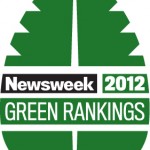 For four years Newsweek has provided environmental scores for corporations, both for the top 500 largest publicly traded firms in America and the top 500 worldwide. Some say that it “cuts through the green chatter and compares actual environmental footprints, management (policies, programs, initiatives, and controversies), and reporting practices.”
For four years Newsweek has provided environmental scores for corporations, both for the top 500 largest publicly traded firms in America and the top 500 worldwide. Some say that it “cuts through the green chatter and compares actual environmental footprints, management (policies, programs, initiatives, and controversies), and reporting practices.”
IBM won the 2012 U.S. distinction. Its Smarter Planet corporate initiative links its customer’s economic growth with sustainable development and societal progress, thanks to increased instrumentation and connectivity, monitoring, analysis, and optimization. It was also recognized for one of its Swiss labs which collects waste heat for nearby buildings. IBM is followed by HP, Sprint, Nextel, and Dell. HP cut its emissions by 50% since 2005. Sprint was the pioneer in used phone return programs.
- Lowe’s, the home improvement store, ranks #11
- Google, featured above, ranks #22
- Disney is #35, Boeing #49, and Ford Motor Company is #50
- Apple is at #118, down 68 ranks due to its second-year refusal to participate in the Carbon Disclosure Project
The ranking uses a 45:45:10 weighting factor for footprint, management, and disclosure. Traditionally “dirty industries” – for instance utilities and mining operations – that have heavy environmental footprints score poorly. Scoring worse yet are dirty industries that also invest in other dirty industries.
Carbon Disclosure Project
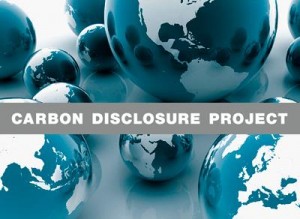 The Carbon Disclosure Project (CDP) is an international non-profit central in the transparency of climate protection, corporate responsibility, and sustainability. It claims to be “the only global system for companies and cities to measure, disclose, manage, and share vital environmental information.” Based in London, England, CDP has been supported by foundations as well as government agencies in the U.K., U.S., Sweden, France, and Holland. Fees for its corporate memberships range from $7,000 – $9,000 per year, depending on gross revenues south or north of $10 billion.
The Carbon Disclosure Project (CDP) is an international non-profit central in the transparency of climate protection, corporate responsibility, and sustainability. It claims to be “the only global system for companies and cities to measure, disclose, manage, and share vital environmental information.” Based in London, England, CDP has been supported by foundations as well as government agencies in the U.K., U.S., Sweden, France, and Holland. Fees for its corporate memberships range from $7,000 – $9,000 per year, depending on gross revenues south or north of $10 billion.
CDP operates with a guiding principle that the first step towards managing carbon emissions is to measure them. Put another way, what gets measured, gets managed. It prepares the annual Global 500 Climate Change Report, and the annual CDP Cities Report. Fully 81% of the world’s 500 largest publically traded companies engage with CDP. It works with thousands of companies to combat climate change; it works with hundreds of institutional investors informing them of the risks of their portfolios to the threats of climate change. CDP also works with supply chain management, and managing water use.
Small Businesses
While the big corporations steal much of the glory, and are to be praised for their great advances, there is an equally impressive greening of small businesses, the home of ingenuity. The Small Business Administration’s Green Business Guide posits the following: “So if you are competitive in terms of price, quality and performance, adding sustainability and green marketing to your business strategy…” This is a new and unique selling point to add to the value proposition of so many sales.
In Atlanta, 17 merchants in the historic corner Virginia-Highland shopping and dining neighborhood banded together to create the first carbon neutral zone in the U.S. The group worked with the Chicago Climate Exchange to directly fund the Valley Wood Carbon Sequestration Project, thousands of acres of forest in rural Georgia.
There are lots of small business resources for going green: Everything from “making your manufacture greener” to lowering taxes by going green. And for small businesses there are “four alternatives to owning a vehicle:” ZipCar/ZipVan; Getaround.com (term rentals); RelayRides.com; and Independent Companies for car and/or van rentals.
One guide for small businesses is based on “eight easy ways:” Begin with powering down, turning off lights, recycling, printing right, buying used, going remote (part or full time), cleaning green, getting involved. Greening indeed takes many forms, from neighborhood clean-up days, to planting a neighborhood garden, and supporting a charitable activity of the employee’s choice like Habitat for Humanity.
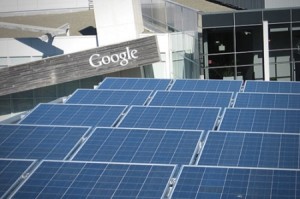 Google has been carbon neutral for six years. And that’s despite a carbon footprint of 1.5 million MTCO2e that it offsets annually. Google has a portfolio of 330 MW of wind in Europe and the United States to support its cloud computing. It gets its renewables from a) utility portfolios (12%), and b) Google-owned renewables (22%), and c) the balance with offsets.
Google has been carbon neutral for six years. And that’s despite a carbon footprint of 1.5 million MTCO2e that it offsets annually. Google has a portfolio of 330 MW of wind in Europe and the United States to support its cloud computing. It gets its renewables from a) utility portfolios (12%), and b) Google-owned renewables (22%), and c) the balance with offsets.
Google’s sustainability strategy first cuts energy use through efficiency, then offsets all power use with green electrons, and then makes investments in wind farms and other energy technologies (Brightsource, SolarCity, the Atlantic transmission backbone) that will bring great benefits to others, and to society. It currently has $1 billion in committed renewable energy projects. Branded Google Green is recognized by both the U.S. EPA and Greenpeace.
Google has 2.5 million square feet of LEED-certified space. Its Mountain View, California campus features a 1.9 MW solar system. It has EV charging modafinil stations, a biodiesel shuttle serve for employees. Its cafeteria serves healthy and sustainable food. Google’s Bike to Work program rewards “self-powered commuters with donations to charities of their choice, based on how often they bike or walk to work.”
Starbucks

Locations utilize repurposed materials
The first Starbucks store opened in 1971 at the Pike Place Market in Seattle. From then on, good beans, well-roasted, and great branding: Now there are more than 18,000 stores in 62 countries. People like coffee, especially Starbucks.
Coffee comes directly from the Earth, so Starbucks connects climate change with profits. It connects climate change with profits: The year 2012 was the hottest on record. This affected coffee growing conditions in Costa Rica. This also caused Starbucks stores to use more power for air conditioning.
So what does sustainability mean for Starbucks? Everything from the sourcing of its products to its store design. The first LEED certified Starbucks store opened in Seattle. Now there are LEED certified stores in 17 countries. Sustainability runs through in design, construction, landscaping, building methods and materials, lighting and more.
Many sociologists believe that coffeehouses are providing a vital function. They are places for people to meet, to connect. The café experience is familiar, inviting. Starbucks designs its stores to fit into the unique character of the community. Its mission is “to inspire and nurture the human spirit – one person, one cup, and one neighborhood at a time.”
JP Morgan Chase
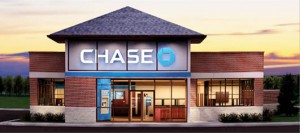
At least 13 branches are LEED certified
JP Morgan Chase is cognizant of its daily impact. With 240,000 employees in 60 countries, its GHG emissions are 3,00 MT per day without air travel and community (Scope 3 factors). A set of principles guide its work in sustainability including the Equator Principles, the Carbon Principles, and the Carbon Disclosure Project. Chase is greening its branches and greening its supply chain. It is in the midst of a LEED Platinum renovation of its New York headquarters.
Then there’s what it calls “Sustainability through Business:” Chase has financed 67 wind farms, fully 16% of the nation’s installed wind capacity. It has provided $6.7 billion in green financing in the form of EcoSecurities. It has eliminated 203 million statements for retail and credit card customers, and now 87% of its paper is purchased from sustainably-managed forests.
The NFL
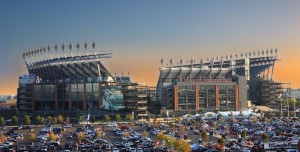
Philadelphia Eagle’s Lincoln Financial Field
Then there’s the NFL: It’s hard to imagine this hard-hitting league looking at ways to reduce its footprint. But it is. Jeff Lurie, owner of the Philadelphia Eagles has taken it on in earnest. His stadium is now carbon free thanks to 11,000 solar panels and 14 wind spires that produce 4 million kWh of green power annually, and the purchase of green power. It also recycles – 993.5 tons of material in 2012. In addition, 480 tons of food, field, and event waste was composted.
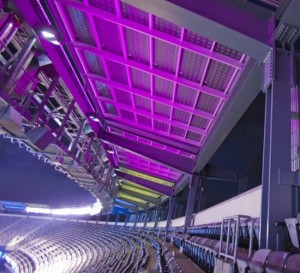
Solar canopy at MetLife Stadium
When they return to Candlestick Park in 2014, the San Francisco 49ers will be returning to the first LEED Gold standard stadium. Gillette Stadium in Foxborough, Massachusetts has cut power use by 30% through upgrades to its automation, solar arrays, and LED lighting. MetLife Stadium in New Jersey has a ring of 1,350 solar panels, lit with LEDs powered by the sun. It is the second largest BIPV project in America, the canopy shades the upper-most seats. Its 47 bays of panels were assembled on the ground and then craned to their racks 180 feet above the ground.
Travelogue: Colorado and New Mexico

Denver’s Light Rail
This past week was great, getting back to the Rockies, seeing friends, making new acquaintances… and visiting Albuquerque and the land of green chile. My six-day trip would take me to Denver for the E Source Forum, to the Roaring Fork Valley where I lived for 12 years near Aspen, and to Albuquerque, New Mexico and a special visit to Central New Mexico Community College.
Flyaway from Union Station to LAX. United to Denver. Easy. Sky Ride to the old Stapleton, now a residential development with a commuter lot. On the bus ride in I see the light rail under construction… Yes! It’s running over hill and dale and all the way downtown. When DIA was built this was a dream. For years, it’s been cars, buses, shuttle, expensive taxi rides. I stay at the Hotel Totelot on Race Street. I’m upstairs; Airbnb in progress downstairs!
26th E Source Forum in Denver, Colorado
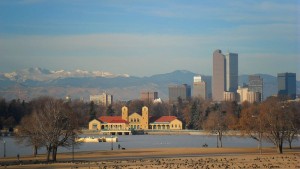
Denver’s City Park
This year’s E Source Forum was a valuable industry event. The 26th Forum, September 17 – 20, attracted nearly 500 participants and energy efficiency practitioners to Denver, Colorado for three days of presentations, workshops, and networking. This year, I was invited to lead a session on the power of messaging and utility partnerships.
Years ago and at Rocky Mountain Institute, I was a founder with Amory Lovins of E Source’s predecessor Competitek. Thus I was especially pleased to be back to the Forum, relishing its unusual blend of technical information, market insights, and casual new-Western behavior. I credit Michael Shepard and his longstanding colleagues for maintaining an appealing culture for information and exchange.
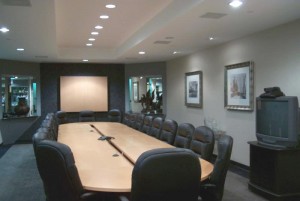
Recessed LED light bulbs
Fellow energy service practitioners hailed from utilities across the country and Canada to the Forum. Lighting has advanced in a positive way. “People never really liked CFLs.” While LEDs are now a force and huge opportunity for savings, a session on commercial LED lighting presented tales from the trenches with this form of solid state lighting, including phenomena like “popcorning.” A session on “the art and math of selling efficiency” highlighted the theme of regulated utilities responding and behaving in progressive market-based ways.
My “Tailoring the Message” presentation focused on three utility partnership programs in California and their results, tapping the power and synergy of creative program design and targeted communications, for groups of customers from facility operators in San Francisco to parishioners, tribal elders, and elected officials in the Coachella Valley.
Working with E Source session host Katie Ruiz, we then divided the audience into five customer types, seniors, students, chambers, “sinks and dinks”, and recent immigrants. They were then sequentially presented five scenarios from nuclear calamity to excess capacity for which each group had to develop effective energy efficiency program marketing language for that specific market segment.
Hiking in the Aspens

Aspen trees
What do I miss most about Colorado?
Skiing? Biking? No, actually hiking. As Charlie Pavek would say, this is God’s country.
Up 82, turn right at the Conoco, past RMI, Windstar, and miles up Snowmass Creek… past the Harvey Ranch and Moon Run to the trailhead.
Chris and I strike forth on Snowmass Creek Trail, through aspen groves. A mile up we pass the beaver ponds we used to visit so often, past the West Snowmass Creek trail, and then continue up the valley toward Snowmass Peak. We walk and talk, the purified air filling our lungs… nature truly is an inspiration.
We parallel the creek, the sound of the flowing water with us throughout. Forests of aspen trees their leaves rustling in the cool breezes of fall, then meadows with majestic views, the first leaves turning, full sunshine and splendor. Blue skies with bulbous clouds coexist above us with 14,000 foot peaks.

Snowmass Creek
We break, cross a log over the rushing stream, to some rocks just perfect for a precarious perch. I take off my shoes and put my feet in the icy cold waters… mentally forcing myself to leave them in there. Ouch. We drink the water and eat apples. The stream is exhilarating. We trek on… thankful for our time together and the power of the Rockies.
STARS at Central New Mexico Community College
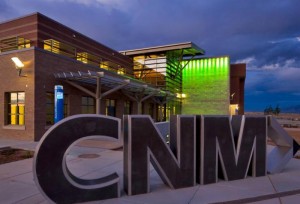
Central New Mexico at dusk
The flight from Denver to Albuquerque is not long, but the change is dramatic. The Albuquerque SunPort feels so far away. The geography changes, from mountains and trees, to rose-colored desert. While Santa Fe is the capitol, Albuquerque is the largest city in New Mexico with a population of 555,417, just more than a quarter of the state’s total population of 2,085,538.
It’s a beautiful state, “the land of enchantment,” from deserts to mesas and snow-capped peaks. New Mexico’s population is the 6th least densely populated in the U.S. It has the highest percentage of Hispanics (46%), and the second highest percentage of Native Americans, after Alaska. The Rio Grande cuts through Albuquerque.
Central New Mexico Community College – the largest post-secondary academic institution in New Mexico — has retained EcoMotion to begin a strategic process toward comprehensive sustainability on campus. The first phase of the project involves an assessment of CNM’s STARS level, and a gap analysis to determine next steps to raise the level to the next STARS certification.

A hot-air balloon flies by campus
CNM is an extraordinary college, growing and with seven campuses and 30,000 students. Students are ushered into an academic path and then guided through the process as needed by CNM Connect, the “center for student success,” a visible and central counseling/guidance function. Closely related, the CNM Foundation provides financial support, right down to helping an individual student make a car payment, breaking through barriers that would otherwise keep young men and women out of schools and professions.
CNM was reformed from the Albuquerque Vocational Technical Institute administered by the Albuquerque Public Schools to Central New Mexico Community College (CNM) in 2006. By 2009, it surpassed the University of New Mexico in size, adjacent to the CNM Main Campus. All of its new buildings are LEED Silver or better. The Rio Rancho campus is air conditioned using ground-source heat pumps.
Today, CNM offers 47 associate degrees and 52 certifications in business, health, and other technical fields. It boasts high classroom utilization rates (students/square foot), and its new buildings, a high facility condition index, a measure of the value of the facility versus its maintenance costs.

Students in the baking program
STARS is the Sustainability Tracking Assessment and Rating System developed for college campuses, what LEED is to the building design community. Thus far, EcoMotion has reviewed all pertinent documentation of campus sustainability activities, and has conducted a site visit in Albuquerque. During the site visit, EcoMotion staff visited five of the seven campuses (including ceramics, aviation, baking, cooking, restaurant, truck driving, nursing learning centers), interviewed more than a dozen stakeholders – from facilities to the president’s office – as well as students on campus in impromptu queries. EcoMotion’s assessment will guide next steps in greening the campus, providing a strategic plan for continual improvement in sustainability and cost savings, as well as deserved recognition.
